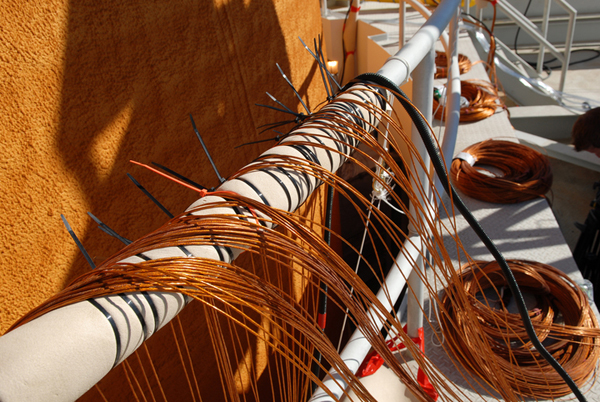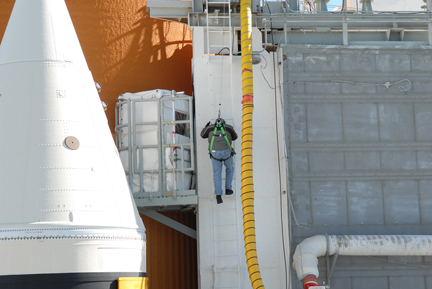Shuttle fueling test on tap Friday
By WILLIAM HARWOOD
CBS News
KENNEDY SPACE CENTER, FL--Engineers working through a modified shuttle launch countdown are preparing to pump a half-million gallons of supercold liquid oxygen and hydrogen rocket fuel into the shuttle Discovery's external tank Friday to collect data needed to assess the tank's structural integrity in the wake of cracked ribs, or stringers, found after a Nov. 5 launch attempt.
Assuming the test goes well and no other problems develop, Discovery will be hauled back to the Vehicle Assembly Building next week for additional X-ray inspections and possible modifications. NASA hopes to move Discovery back to pad 39A in mid-January for work to ready the ship for another launch attempt as early as Feb. 3.
The cracks in question are located near the top of the external tank's ribbed intertank section where a large flange supports a liquid oxygen tank. Four cracks were found in two adjacent stringers near one of the tank's two booster-attachment thrust panels. The cracks were repaired by splicing in undamaged sections and installing so-called "doublers" to add additional strength.
But engineers are still working to pin down what caused the cracks in the first place. Without a confirmed root cause, analysts cannot rule out the possibility that additional cracks could form, possibly compromising the tank's structural integrity or resulting in the loss of foam insulation that could pose an impact threat to the shuttle's fragile heat shield during ascent.
While inspections using X-ray equipment should catch any pre-existing cracks, initial results of testing using external tank hardware subjected to predicted launch day loads indicates a loss of structural safety margin if two or three adjacent stringers in critical areas were damaged enough to be considered "failed."
As a result, engineers are assessing so-called "radius-block" reinforcements that could be attached to beef up the 36 stringers on either side of the thrust panels where the shuttle's two solid-fuel boosters attach. Those stringers, nine on either side of both thrust panels -- including the two that were repaired -- experience the most stress and are most prone to assembly problems during manufacturing.
The fueling test was ordered to precisely characterize the stresses acting on the stringers before launch, when the tank is subjected to extremely low temperatures. Engineers cut away insulation and installed 21 stain gauges and 39 temperature sensors, or thermocouples, on and near the repaired stringers on the left side of the space shuttle. Another 18 strain gauges and 21 thermocouples were attached to the skin of the tank near the right-side thrust panel. Engineers then re-applied foam insulation.
The sensors will measure the stresses acting on the stringers as liquid oxygen, at minus 298 degrees Fahrenheit, is pumped into the tank along with liquid hydrogen, at minus 423 degrees. As the tanks contract in the ultra-low temperatures, the stringers will be subjected to bending stresses near the oxygen and hydrogen tank flanges. They are designed for that, but analysts want to characterize exactly how much stress might be present and map out thermal gradients in the area.
The fueling test has four primary goals:
Along with measuring stresses and temperatures, stereo cameras will be focused on thousands of small dots painted on the tank to document subtle changes indicative of internal components shrinking on exposure to low temperatures.
After the test is complete, cabling will be removed and Discovery will be hauled back to the Vehicle Assembly Building Dec. 21. After Christmas, engineers will carry out X-ray inspections all the way around the circumference of the tank at both the liquid hydrogen and oxygen flanges at the top and bottom of the intertank section. The instrumentation is capable of spotting even small cracks beneath the foam insulation.
Repair crews will remove the strain gauges and thermocouples and apply fresh foam insulation. And they likely will be directed to attach the additional radius block doublers near the thrust panels to provide an additional safety margin.
Engineers say the reinforcement hardware can be installed in time to support another launch attempt Feb. 3. But that assumes no problems emerge from the tanking test and that work to remove instrumentation and repair the tank's foam goes smoothly.
CBS News
 |
| Technicians install sensors and photo targets on the shuttle Discovery's tank in preparation for a fueling test Friday. (Photo: NASA) |
KENNEDY SPACE CENTER, FL--Engineers working through a modified shuttle launch countdown are preparing to pump a half-million gallons of supercold liquid oxygen and hydrogen rocket fuel into the shuttle Discovery's external tank Friday to collect data needed to assess the tank's structural integrity in the wake of cracked ribs, or stringers, found after a Nov. 5 launch attempt.
Assuming the test goes well and no other problems develop, Discovery will be hauled back to the Vehicle Assembly Building next week for additional X-ray inspections and possible modifications. NASA hopes to move Discovery back to pad 39A in mid-January for work to ready the ship for another launch attempt as early as Feb. 3.
The cracks in question are located near the top of the external tank's ribbed intertank section where a large flange supports a liquid oxygen tank. Four cracks were found in two adjacent stringers near one of the tank's two booster-attachment thrust panels. The cracks were repaired by splicing in undamaged sections and installing so-called "doublers" to add additional strength.
But engineers are still working to pin down what caused the cracks in the first place. Without a confirmed root cause, analysts cannot rule out the possibility that additional cracks could form, possibly compromising the tank's structural integrity or resulting in the loss of foam insulation that could pose an impact threat to the shuttle's fragile heat shield during ascent.
While inspections using X-ray equipment should catch any pre-existing cracks, initial results of testing using external tank hardware subjected to predicted launch day loads indicates a loss of structural safety margin if two or three adjacent stringers in critical areas were damaged enough to be considered "failed."
As a result, engineers are assessing so-called "radius-block" reinforcements that could be attached to beef up the 36 stringers on either side of the thrust panels where the shuttle's two solid-fuel boosters attach. Those stringers, nine on either side of both thrust panels -- including the two that were repaired -- experience the most stress and are most prone to assembly problems during manufacturing.
 |
| Strain gauges and temperature sensors were attached to the tank and then covered with foam insulation. In this photo, wiring from the sensors hints at the complexity of the test. (Photo: NASA) |
The fueling test was ordered to precisely characterize the stresses acting on the stringers before launch, when the tank is subjected to extremely low temperatures. Engineers cut away insulation and installed 21 stain gauges and 39 temperature sensors, or thermocouples, on and near the repaired stringers on the left side of the space shuttle. Another 18 strain gauges and 21 thermocouples were attached to the skin of the tank near the right-side thrust panel. Engineers then re-applied foam insulation.
The sensors will measure the stresses acting on the stringers as liquid oxygen, at minus 298 degrees Fahrenheit, is pumped into the tank along with liquid hydrogen, at minus 423 degrees. As the tanks contract in the ultra-low temperatures, the stringers will be subjected to bending stresses near the oxygen and hydrogen tank flanges. They are designed for that, but analysts want to characterize exactly how much stress might be present and map out thermal gradients in the area.
The fueling test has four primary goals:
- Gather full-scale environmental data to help validate sub-scale testing and analysis
- Determine if there are structural issues with the intertank that are the result of generic manufacturing issues as opposed to isolated problems with specific stringers
- Verify that the repaired stringers perform normally during fueling
- Verify that a gaseous hydrogen vent line attached to the side of the tank is leak free. A quick-disconnect fitting leaked during fueling Nov. 5, triggering a launch scrub
EST........EVENT
01:00 AM...Final fueling preps
03:00 AM...Pad clear
06:00 AM...Begin a one-hour built-in hold
07:00 AM...Resume countdown
07:00 AM...Liquid oxygen/hydrogen transfer line chill down begins
07:10 AM...Liquid hydrogen slow fill begins
07:40 AM...Liquid oxygen slow fill begins
07:45 AM...Hydrogen engine cutoff sensors "wet"
07:50 AM...Liquid oxygen fast fill begins
08:00 AM...Liquid hydrogen fast fill begins
09:15 AM...Liquid hydrogen topping (98 percent full)
09:45 AM...Liquid hydrogen replenish
10:00 AM...Liquid oxygen stable replenish
10:00 AM...Begin a one-hour built-in hold
10:00 AM...Final inspection team at the launch pad
11:00 AM...Resume countdown
01:00 PM...Final inspection team departs launch pad
01:40 PM...Begin a 10-minute hold at T-minus 20 minutes
01:50 PM...NASA test director briefing
01:50 PM...Resume countdown
02:01 PM...Begin a 10-minute hold at T-minus 9 minutes
02:05 PM...NASA test director launch status verification
02:11 PM...Resume countdown
02:11 PM...Ground launch sequencer auto sequence start
02:16 PM...Terminate liquid oxygen replenish
02:18 PM...Liquid oxygen tank pressurization
02:19 PM...Liquid hydrogen tank pressurization
02:20 PM...Begin a five-minute hold at T-minus 31 seconds
02:24 PM...Fueling test ends
02:50 PM...Liquid oxygen drain begins
02:55 PM...Liquid hydrogen drain begins
 |
| A technician climbs to a makeshift workroom on the side of Discovery's external tank where cracked ribs, or stringers, were discovered after a launch attempt Nov. 5. (Photo: NASA) |
After the test is complete, cabling will be removed and Discovery will be hauled back to the Vehicle Assembly Building Dec. 21. After Christmas, engineers will carry out X-ray inspections all the way around the circumference of the tank at both the liquid hydrogen and oxygen flanges at the top and bottom of the intertank section. The instrumentation is capable of spotting even small cracks beneath the foam insulation.
Repair crews will remove the strain gauges and thermocouples and apply fresh foam insulation. And they likely will be directed to attach the additional radius block doublers near the thrust panels to provide an additional safety margin.
Engineers say the reinforcement hardware can be installed in time to support another launch attempt Feb. 3. But that assumes no problems emerge from the tanking test and that work to remove instrumentation and repair the tank's foam goes smoothly.